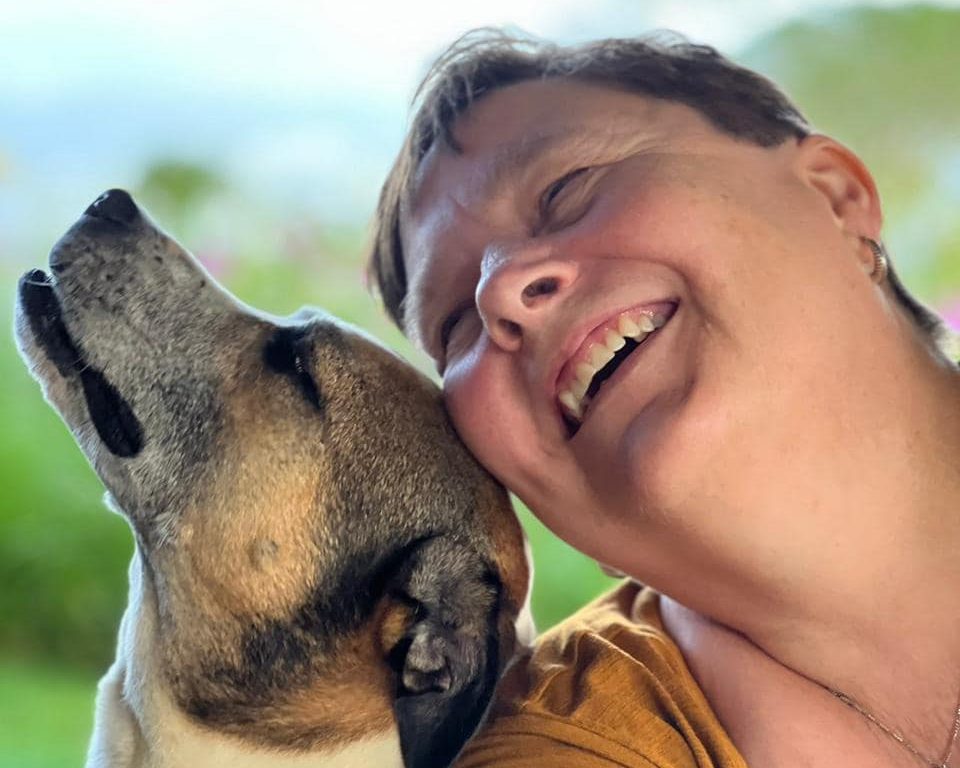by Heather Plett
Last week, while hosting our Liberation and Tenderness gathering in Costa Rica, I was asked to explain the difference between tenderness and kindness. My response was something like this:
Tenderness has the added quality of vulnerability that isn’t inherent in kindness. I can be kind to you without being vulnerable, but I can’t be tender with you with no vulnerability. The same goes for the way I treat myself.
Tenderness reminds me of the way a loving caregiver soothes an upset child (or the way Mary’s dog loved on me in the picture above). When I am tender with myself, I offer myself that same gentle, soft, soothing quality that lets me know that I am safe and that I belong.
That quality of softness and gentleness can not be fully realized unless there is some vulnerability on both sides. If there is guardedness present in one but not the other, then tenderness might be offered but not received. If there is guardedness present in the offering itself, then kindness might be possible, but tenderness will be illusive. If there is guardedness in both, there will be no tenderness until somebody softens and becomes more vulnerable, inviting the other into that tender space. (Sometimes, guardedness has a way of masquerading as “niceness”, when a person is overly solicitous but not willing to show their vulnerable side.)
It reminds me of the Buddhist principle of “strong back, soft front”. Zen Buddhist Rossi Joan Halifax says: “All too often our so-called strength comes from fear, not love; instead of having a strong back, many of us have a defended front shielding a weak spine. In other words, we walk around brittle and defensive, trying to conceal our lack of confidence. If we strengthen our backs, metaphorically speaking, and develop a spine that’s flexible but sturdy, then we can risk having a front that’s soft and open, representing choiceless compassion. The place in your body where these two meet – strong back and soft front – is the brave, tender ground in which to root our caring deeply.”
When we are present in places where there is no safety available to us, or when we haven’t yet found people who know how to hold space for us, then that guardedness might be necessary for a time, to protect the tenderness in our hearts, but it is not the end of the story.
For genuine healing, liberation, and transformation to happen, vulnerability is an important component. When we are unwilling and/or unable to be vulnerable, then we guard our wounds, stay reactive in their protection, and don’t allow them to be soothed or healed. In the case of trauma, the guardedness might become dissociation where we’re not fully aware of what we are protecting or why.
As Gabor Maté reminds us in The Myth of Normal, vulnerability is one of the many things that nature teaches us about how to evolve. “Nothing in nature ‘becomes itself’ without being vulnerable: the mightiest tree’s growth requires soft and supple shoots, just as the hardest-shelled crustacean must first molt and become soft. The same goes for us: no emotional vulnerability, no growth. Even our ’tougher’ qualities like resilience, determination, confidence, and bravery, if authentic and not mere bluster, have that softer state as a necessary precursor.”
I was walking through the Costa Rican jungle recently when I noticed a tree with spiky thorns all the way up its trunk. Clearly that’s a tree that has evolved a way to protect itself from any jungle creatures that might want to climb its trunk to eat its seeds, fruit, or leaves. I paused to take a picture of that tree trunk, thinking of it as a good metaphor of the ways in which we become guarded and protect ourselves from those who cause harm. But after reading Gabor Maté’s quote, I realize that even that thorny tree needed tenderness in order to grow into what it is now. It needed tenderness for its seed to crack open, tenderness to root itself, and tenderness to grow into a tiny sprout before it could grow thorns to protect itself. It also needs tenderness (protected by those thorns on its trunk) to grow the leaves and seeds that help it thrive and reproduce other trees like it.
I chose tenderness to go along with liberation in this work because I believe that tenderness is the path that takes us to liberation. Our cultures and families (and especially those systems that cause us harm) do not necessarily teach us to be tender. In fact, in The Myth of Normal, Maté quotes Gordon Neufeld’s research that shows that children are losing their tenderness from growing up in cultures that don’t offer enough safety and belonging when they are most tender.
Because it’s not been modeled for most of us, we have to relearn tenderness and we have to liberate ourselves from the judgement that has associated it with weakness. When we relearn it, we find that our courage and strength come along with the tenderness (especially when we embed it into community) and we are better able to stand up to harmful systems and not contribute to the perpetuation of that harm (i.e. “strong backs”). We become like that thorny tree – protecting our tender spaces for the leaves and seeds to grow, and even welcoming birds into our softer branches, but growing the necessary thorns to ward of the harm of the systems that don’t have our best interests at heart.
The best place to start practicing tenderness is with yourself. I encourage you to find some time today to be especially tender with yourself. Give yourself soothing touch, forgive yourself for making a mistake and/or write a message from Tenderness to you in your journal.
If you want to learn more, I hope that you will join us in the upcoming session of Know Yourself, Free Yourself: self-exploration as a path to liberation and love. We’ll talk a lot about tenderness in the community conversations we’ll have during those eight weeks.

